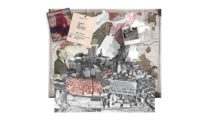Celebrating 125 Years: Looking Forward
Material Futures
Designers and architects are going back to basics to develop an innovative palette of building blocks for generations to come.

For an artists’ residence and cultural center in Senegal, Toshiko Mori created a thatch roof that captures rain and channels it into water canals to a cistern.
Photo © Iwan Baan

A model of LEVER Architecture’s 12-story Framework tower in Portland, Oregon, which will be the tallest Mass timber project in the U.S.
Image courtesy LEVER Architecture

German architect Anna Heringer’s installation at the 2016 Venice Architecture Biennale showcases the potential of traditional building techniques with mud.
Photo © Bruno Klomfar

Seaweed is abundant and available around the world, and when dried it becomes a robust material. London-based German designer Julia Lohmann is experimenting with it to demonstrate its capabilities for building temporary structures.
Photo © Petr Kreci

Seaweed is abundant and available around the world, and when dried it becomes a robust material. London-based German designer Julia Lohmann is experimenting with it to demonstrate its capabilities for building temporary structures.
Photo © Petr Kreci

GXN director Kasper Guldager Jensen and his team explore the value of bio-based materials.
Image courtesy GXN

Dierichs and Menges devised a construction system of recycled plastic components.
Photo © ICD University of Stuttgart 2015

Newspaper Wood makes woodlike building products from recycled newspaper.
Photo © Raw Color

Sensory skins display graphics, regulate lighting, and absorb sound at Al Jazeera’s London studio.
Photo © Hufton + Crow









Materials have undergone a radical transformation. All over the world, a fresh crop of tech-savvy, socially engaged architects are seeing traditional options with new eyes. Factors such as geopolitics and mass migration are fueling demands for lightweight, labile materials, while the need for emergency supply chains requires multifunctional building blocks that can be assembled on the fly. Just as conventional resources are being rediscovered or repurposed, digital technologies pave the way for smart interiors and facades. Modern materials are no longer passive; they can function as sensory components that harvest energy, interface with their surroundings, and respond to the surfaces around them. As architects combine parametric tools and traditional craftsmanship, they are discovering materials that limit neither and sometimes amplify both.
Widely known for his preference for humble materials and appreciation of craft, Swiss architect Peter Zumthor was just one of the participants who identified a shift toward “handmade architecture” at the International Architecture Biennale in Venice this summer. According to Zumthor, the industry is slowly returning to simple, unfinished materials such as wood, stone, clay, and thatch. Recent innovations in timber technology indicate that Zumthor is right, especially since engineered wood products such as CLT (cross-laminated timber) have evolved to become significant building materials. In the hands of Thomas Robinson, founder of LEVER Architecture in Portland, Oregon, CLT and glue laminated timber are rising to new heights as they are used to construct LFRS (lateral force resisting systems), beams, and tall columns. Robinson’s 12-story mixed-use Framework tower is slated for construction in Portland’s trendy Pearl District next year. “The post-tensioned wood rocking shear walls in the Framework project are the primary expression of the facade and drive the plan,” says Robinson. Additionally, Robinson reports that his firm’s Albina Yard project in North Portland features the first structural use of domestically fabricated CLT panels in the United States.
New York architect Toshiko Mori designed a multiuse cultural center in Senegal that was completed last year (RECORD, June 2015). Grasses growing on-site were harvested and dried to fashion the structure’s sloping thatch roof, which collects rain and channels it into water reservoirs that then drain into covered cisterns. “Traditional techniques were used to make the roof,” says Mori. “The materials and craft are known to everyone, so repairs can be made readily.”
German architect Anna Heringer also turned to local resources, discovering that mud may have potential for modern structures. Heringer first used mud bricks in 2007 to build a school in Bangladesh, and today cites it as an example of a readily available global resource. More recently, the architect’s installation at the 2016 Venice Biennale, which comprises 25 tons of mud from locally sourced clay, demonstrates age-old techniques viable for the 21st century: rammed earth, mud-casein wall colors, and zabur, a technique of shaping through layering the mud by hand.
Seaweed, too, is slated to join the ranks of grassroots materials. German designer Julia Lohmann is pioneering prototypes and installations that explore its applications for architecture and design. “As I experiment with naga kombu and other types of seaweed, I discover it has the strength and robustness typical of building materials,” Lohmann says. Her experiments with stretching dried seaweed over a cane frame resulted in a freestanding installation, revealing the material’s potential for building temporary structures. At the same time, Danish architect Kasper Guldager Jensen, GXN director and partner at 3XN and coauthor of Building a Circular Future, is exploring the value of biobased building materials produced from seaweed and agricultural waste such as tomato stems and flax fibers. “Both biological and technical materials should be up-cycled,” Jensen says. “Creating man-made material ecosystems is the ultimate design challenge.”
Such grassroots resources are often derived from reclaimed materials or elements created from recycled sources. Lauded for its versatility and strength, recycled paper can be used to make acoustic panels, wall and floor tiles, and load-bearing structural components. Based in the Netherlands, the designers behind Newspaper Wood reverse the norm of pulping wood to make paper: they recycle newspaper to create an alternative to wood. Lightweight and strong, the newspaper used to fabricate the material is compressed so densely that its layers resemble wood grain when cut.
Nature provided the inspiration for a modular system of building components based on grains and granular particles. Karola Dierichs and Achim Menges, both architects teaching at the Institute for Computational Design in Stuttgart, Germany, used recycled plastic that had been extruded into pellets as raw material for the injection-molded components they designed. Their modular system of star-shaped granular particles can be assembled in layers to build freestanding structures without requiring binding agents, framework, or forms. Distinct Element Modeling (DEM) simulations were used to analyze the structural performance of the recycled material, revealing that the system is robust enough to create load-bearing structures without requiring any additional support.
Although technologically fuelled components may appear to be a direct counterpoint to low-tech, traditional materials, there is scope for the two to coexist. Based in Vienna, Veech x Veech integrates advanced media technologies into everyday architectural materials to create programmable surfaces and immersive interiors. Ready-made products, such as luminous textile panels, are installed alongside components crafted from acrylic-based solid surface materials developed to showcase digital images and animations. When Veech x Veech designed Al Jazeera’s new broadcast studio in the Shard in London last year (RECORD, August 2015), it created sensory skins that display graphics, regulate lighting, and absorb sound. According to Stuart Veech, who cofounded the practice with Mascha Veech-Kosmatschof, “The integration of materials and technologies enabled us to blur the boundaries between the real-time, analog studio environment and immersive digital spaces, subsequently going beyond the norm of the existing black-box studio.” Technologies like these can make every environment interactive, yet often rely on traditional materials to construct panels and surfaces to contain them.
New materials, whether derived from organic sources such as seaweed or fabricated from recycled plastic, will conserve resources and up-cycle waste. As such technologies are integrated into buildings, traditional materials and digital systems may converge to create responsive environments. The very same craftsmanship and conventional constituents that are highly valued today promise to play key roles in the interactive architecture to come.













